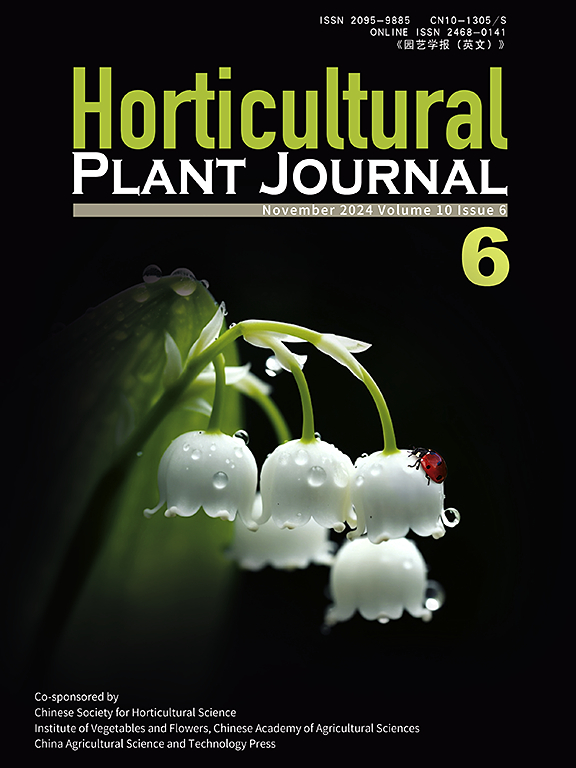AaEIL2和AaERF059通过交叉调控乙烯和生长素信号通路参与枣猕猴桃果实的着色和成熟过程
IF 6.2
1区 农林科学
Q1 HORTICULTURE
引用次数: 0
摘要
在猕猴桃(猕猴桃)中,果实的颜色通常伴随着成熟;然而,这两个过程之间的内在联系尚不清楚。在本研究中,我们发现乙烯和生长素分别促进和抑制了软枣果实的着色和成熟。利用酵母双杂交文库筛选和转录组分析,对乙烯不敏感3-LIKE 2 (AaEIL2)和乙烯响应因子(AaERF059)进行了筛选和鉴定。通过对AaEIL2在拟南芥原生质体中的亚细胞定位、在转基因番茄中的稳定遗传转化、酵母单杂交和荧光素酶活性的研究,证实AaEIL2是一种由乙烯特异性诱导高表达的转录因子,并以AaLDOX(参与花青素生物合成的白花青素双加氧酶)和AaPG18(参与细胞壁降解的多聚半乳糖酶)为靶点,积极调控着色和成熟。AaERF059还通过靶向下游基因AaACS2(参与乙烯生物合成的ACC合成酶)和AaGH3(参与生长素途径的grethen - hagen 3)调控乙烯/生长素介导的果实着色和成熟。总体而言,AaEIL2和AaERF059通过正、负调节方式维持动态平衡,调控乙烯和生长素介导的果实着色和成熟。我们的研究结果不仅鉴定了软枣果实颜色与成熟之间的关键基因,还建立了软枣果实颜色与成熟的内在联系。本文章由计算机程序翻译,如有差异,请以英文原文为准。
AaEIL2 and AaERF059 are involved in fruit coloration and ripening by crossly regulating ethylene and auxin signal pathway in Actinidia arguta
In kiwifruit (Actinidia arguta ), fruit coloration is typically accompanied by ripening; however, the intrinsic connection between these two processes remains unclear. In this study, we found that ethylene and auxin accelerated and suppressed fruit coloration and ripening, respectively, in A. arguta . ETHYLENE INSENSITIVE 3-LIKE 2 (AaEIL2) and ETHYLENE RESPONSIVE FACTOR (AaERF059) were mined and identified using yeast two-hybrid library screening and transcriptome analysis. AaEIL2, specifically induced to high expression by ethylene, was confirmed as a transcription factor that positively regulates coloration and ripening by targeting AaLDOX (leucoanthocyanidin dioxygenase involved in anthocyanin biosynthesis) and AaPG18 (polygalacturonase involved in cell wall degradation) based on its subcellular localization in Arabidopsis protoplasts, stable genetic transformation in transgenic tomato, and yeast one-hybrid and luciferase activity assays. AaERF059 also responds to ethylene and regulates ethylene-/auxin-mediated fruit coloration and ripening by targeting the downstream genes AaACS2 (ACC synthase, which is involved in ethylene biosynthesis) and AaGH3 (Gretchen-Hagen 3, which is involved in the auxin pathway). Overall, AaEIL2 and AaERF059 regulate ethylene-and auxin-mediated fruit coloration and ripening by maintaining a dynamic balance in a positive and negative regulatory manner. Our results not only identified key genes but also established an intrinsic connection between fruit coloration and ripening in A. arguta .
求助全文
通过发布文献求助,成功后即可免费获取论文全文。
去求助
来源期刊

Horticultural Plant Journal
Environmental Science-Ecology
CiteScore
9.60
自引率
14.00%
发文量
293
审稿时长
33 weeks
期刊介绍:
Horticultural Plant Journal (HPJ) is an OPEN ACCESS international journal. HPJ publishes research related to all horticultural plants, including fruits, vegetables, ornamental plants, tea plants, and medicinal plants, etc. The journal covers all aspects of horticultural crop sciences, including germplasm resources, genetics and breeding, tillage and cultivation, physiology and biochemistry, ecology, genomics, biotechnology, plant protection, postharvest processing, etc. Article types include Original research papers, Reviews, and Short communications.
 求助内容:
求助内容: 应助结果提醒方式:
应助结果提醒方式:


